Gluten-Free Sourdough Starter
Published
Sourdough bread has been rising in popularity in the last few years, but did you know that it can be made gluten-free? I’ve been perfecting this recipe for a bubbly, active gluten-free sourdough starter for a few months, and it works so well for making gluten-free sourdough bread. This is a simple combination of flour, water, and wild yeast from the environment that creates a live fermented culture. This preferment is what gives bread a nice, fluffy rise without the use of commercially prepared yeast.
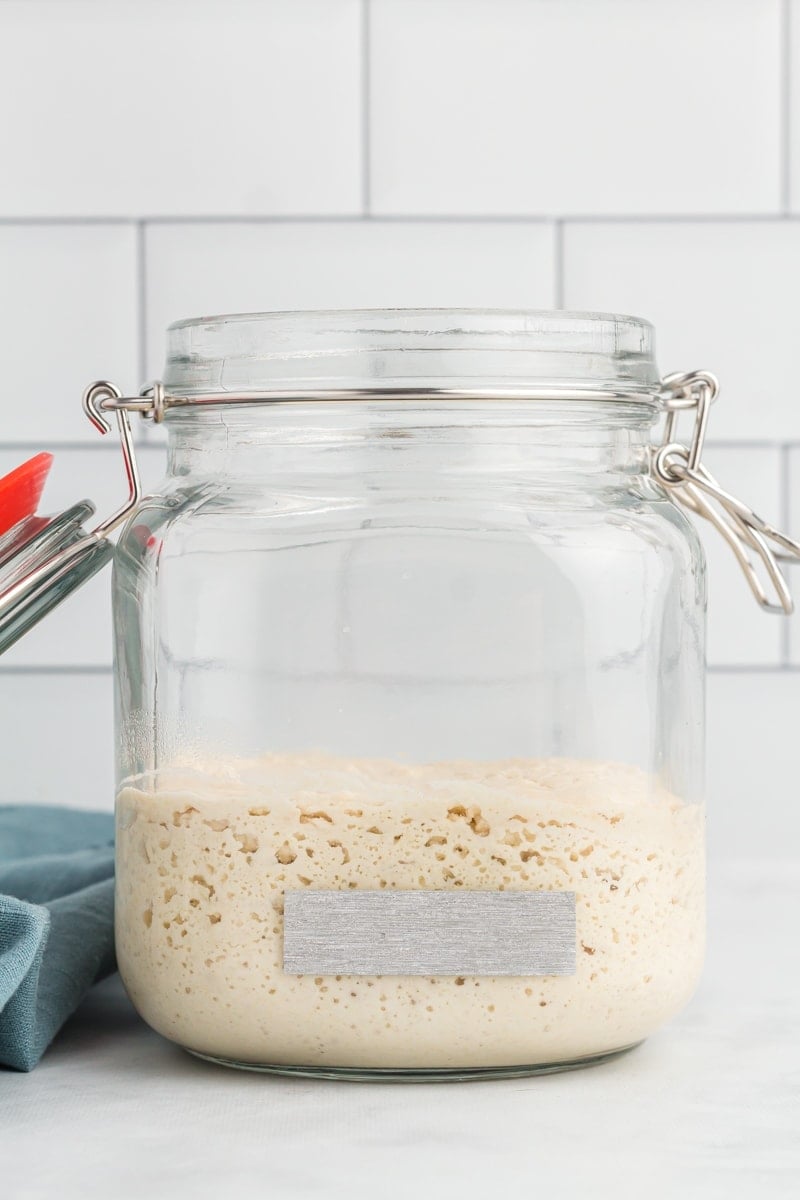
Gluten-Free Sourdough Starter Recipe
The idea of creating a gluten-free sourdough starter may seem a bit overwhelming, but it’s a lot easier than you think. You need just two ingredients to get started and a few minutes each day to feed it. Within about two weeks, you’ll have an active sourdough preferment that you can continue to feed and use in all your favorite gluten-free sourdough recipes.
Although the process is quite easy, there are a lot of things to note when you’re getting started, such as proper temperatures, the right tools to use, how to know if it’s working or if you need to start over, and so on. Through extensive testing, I’ve come up with a guide that takes all of the guesswork out of it.
Read this post in its entirety before getting started and keep it handy to reference!
Ingredients
- Whole Grain Gluten-Free Flour: There are a few different types of gluten-free flour that can be used (for example: brown rice flour, buckwheat flour, sorghum flour, millet flour, etc.), but the most important thing is to avoid options with added starches, gums, and other additives. For this recipe, I used brown rice flour.
- Filtered Water: Regular tap water can have chlorine in it, which inhibits the growth of good bacteria, so it’s best to use filtered water. Do not use distilled water since that won’t have the minerals needed.
Supplies
- Food Scale: A lot of measuring is required. Be sure to use a food scale rather than guessing or estimating quantities.
- Glass Jar: A 1-quart glass jar should be large enough. A clear, straight-sided jar is best so that it’s easier to scrape down between feedings. Extra ridges in the jar can be a breeding ground for mold.
- Wooden Spoon: Some experts say a wooden spoon is needed and others say stainless steel is fine. Some warn to stay away from metal or stainless steel utensils because sourdough is made with acid that will react to the metal. Experts are split on if this matter, but we recommend sticking to a wooden spoon to be safe.
- Silicone Spatula: Use a flexible one to scrape down the inside of the jar at each feed.
- Colored Tape or an Elastic Band: This will be placed on the outside of the jar to measure growth between each feed. Choose something that’s easy to move along the jar and won’t fall off easily.
- Clean Towel or Food-Safe Plastic Wrap: The sourdough starter will need to be covered in between feedings. Do not seal the jar completely. You need air to grow the yeast, so a light cover will maintain airflow.
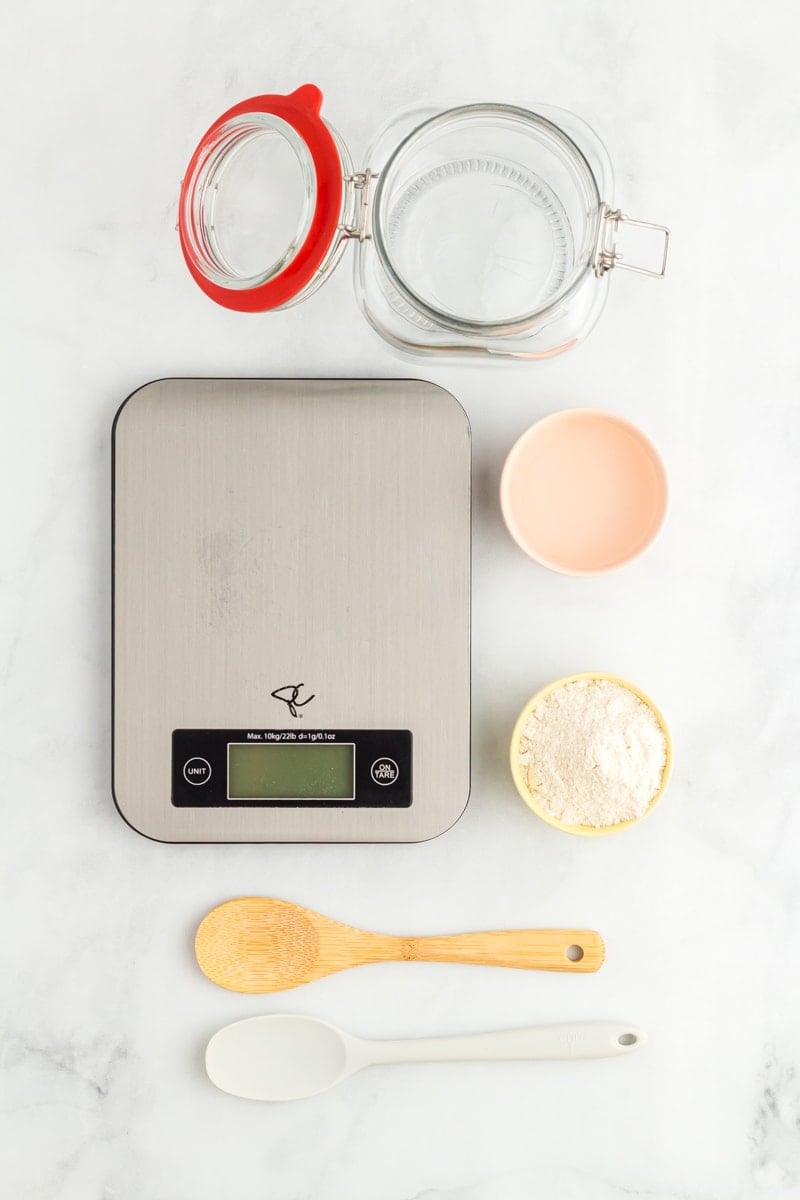
Tips and Notes
- The amount of flour and filtered water needed for this recipe varies depending on how long it takes to build a strong active sourdough starter. Depending on the time of year, the temperature in your house, and other factors, it could take 2 full weeks to see a good rise. This recipe calls for 3 pounds of gluten-free brown rice flour to start, but you may not need all of it.
- Store the jar in a warm, draft-free area. Do not place this by a window, a door, a cold exterior wall, or in direct sunlight (too much heat will kill the yeast).
- For the first week, the sourdough starter is going to smell bad. This is normal! As long as there isn’t mold growing in it, it’s still good. It takes at least a week (usually two weeks) before it starts emitting a pleasant, yeasty bread scent.
- When you switch from twice-a-day feedings to once-a-day feedings, it’s normal for the activity level to decrease. You may see less rise and not as many bubbles. This is normal and usually lasts 2 to 3 days after switching to once-a-day feedings. Just keep going with the 24-hour feeds and your starter will start to become more active again.
- Keep the mouth of your jar, the lid area, and any ridges inside the jar clean. Use a slightly damp clean cloth to wipe the inside of the jar down after every couple of feeds. If you leave old starter to dry out and stick to the inside of the jar, it could be a breeding ground for mold.
What Happens If I Miss A Feed?
A sourdough starter can be quite forgiving. If you miss a feed by a few hours or even a day, just pick up where you left off. You may see a decrease in activity at first, but it’ll pick up within a couple of days after regular feedings are resumed.
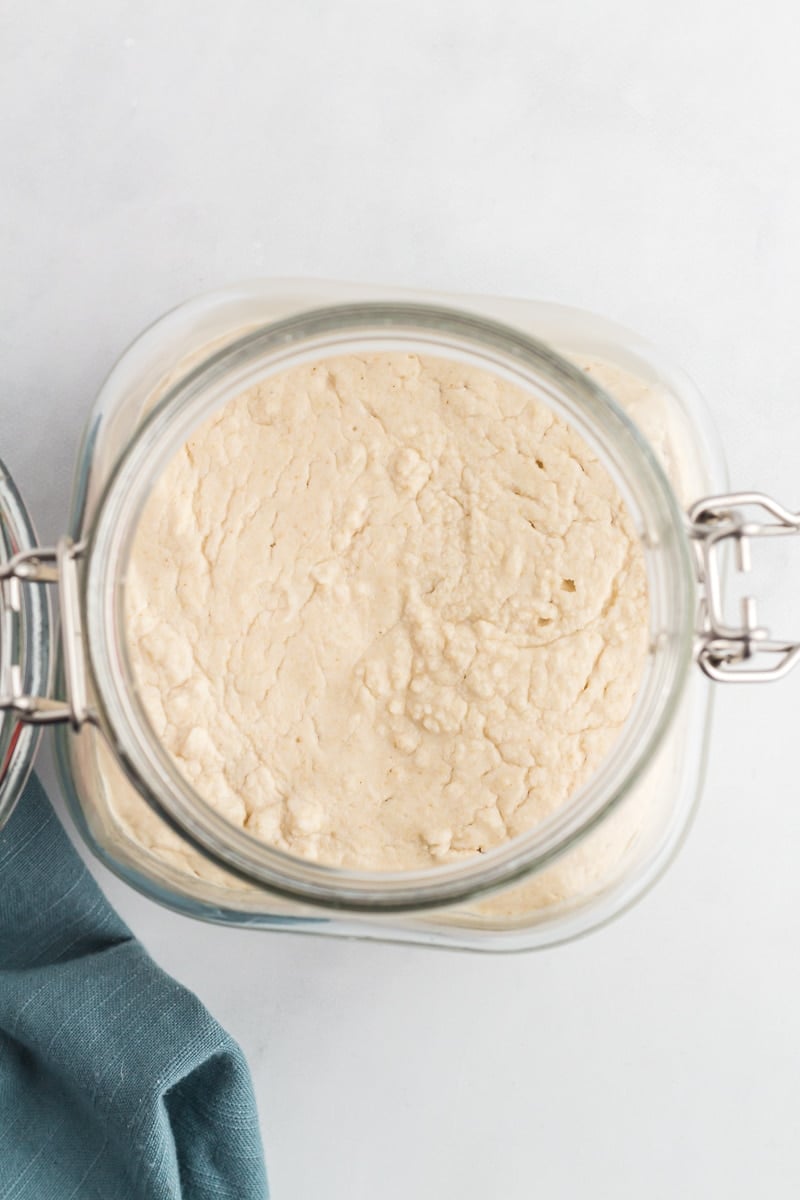
Do I Have To Throw Away The Discard?
No, there are still lots of uses for discard! Although the discard won’t be good for bread, you can use the discard to add a distinct tangy flavor to biscuits, muffins, cookies, and pancakes. Store the discard in the fridge if you plan to use it later for another recipe.
What Is The Liquid On Top?
If your starter starts to get a liquid forming on the top of it, it’s likely hooch (a naturally occurring alcohol). This sometimes starts to form if it’s been too long between feedings. Pour it off and continue feeding as normal.
What Are Signs That It Has Gone Bad?
Once your starter has mold growing in it, you’ll unfortunately have to discard it all and start over again. If it starts changing colors or getting a pink, white, green, brown, or black layer over the top, it’s time to throw it away and restart.
However, if you see a bit of mold on the jar only, wipe it off carefully and transfer your starter to a new clean jar.
Storage Instructions
Store gluten-free sourdough starter in a clean, covered jar at room temperature indefinitely. If you plan to feed it less often, store it in the refrigerator.
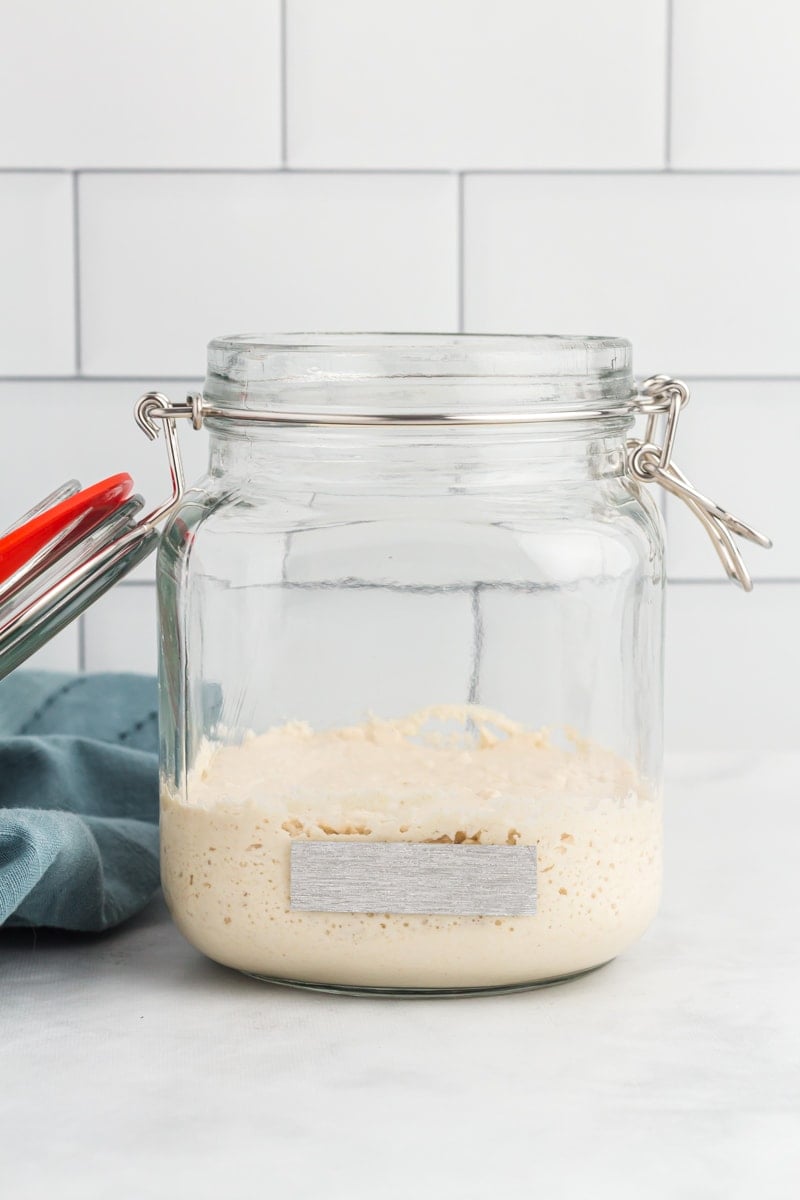
While some patience and measuring are required, once you get the hang of this gluten-free sourdough starter recipe, it’s easy to keep it going. You’re just two weeks from a lifetime of delicious gluten-free sourdough bread!
More Gluten-Free Bread Recipes to Try!
- Easy Gluten-Free Bread
- Gluten-Free Bread Machine Bread
- Gluten-Free Sweet Cornbread
- Gluten-Free Irish Soda Bread
Gluten Free Sourdough Starter Recipe
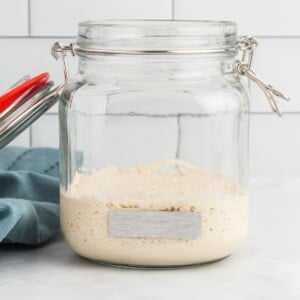
Ingredients
- 1400 grams whole grain gluten-free flour, I used brown rice flour
- 1400 grams filtered water
Instructions
- Weigh the empty glass jar. You’ll refer back to this weight daily so make sure you write the number down and have it near your prep area.
- Day 1 First Feed: In the clean and dry glass jar, add 50 grams of brown rice flour and 50 grams of room temperature filtered water. It’s okay if you’re a few grams above or below 50 grams each when doing the daily feedings. The consistency should look like a thin paste that’s a bit thicker than pancake batter. Add a little extra water or flour if needed. Stir well with a wooden spoon, then use the spatula to scrape down the inside of the jar. Place the colored tape or elastic band at the height of the starter. Cover the jar loosely with a clean towel or plastic wrap and set it in a warm location in your home away from direct sunlight.
- Day 1 Second Feed (12 hours after Day 1 First Feed): Stir the starter with a wooden spoon. Add an additional 50 grams of brown rice flour and 50 grams of room temperature filtered water. Stir well with a wooden spoon. Use the spatula to scrape down the inside of the jar. Move the colored tape or elastic band to the height of your starter. Cover the jar loosely with a clean towel or plastic wrap and set the jar back in a warm location.
- Day 2 First Feed (12 hours after Day 1 Second Feed): Repeat steps of Day 1 Second Feed.
- Day 2 Second Feed (12 hours after Day 2 First Feed): Repeat steps of Day 1 Second Feed.
- Day 3 First Feed (12 hours after Day 2 Second Feed): Stir the starter with a wooden spoon. Discard all but 100 grams of the starter. This is where your math comes in handy. Let’s say your jar was 730 grams. When you stir and discard all but 100 grams of starter, your food scale should now read approximately 830 grams (730 grams for the jar, plus 100 grams for the starter in it). Now add an additional 50 grams of brown rice flour and 50 grams of room temperature filtered water. Using the math, the 730 jar plus the 100 grams of starter in it plus the 50 grams of additional brown rice flour plus the 50 grams of additional filtered water, the weight of all would now be around 930 grams. Stir well with a wooden spoon. Use the spatula to scrape down the inside of the jar. Move the colored tape or elastic band to the height of your starter. Cover the jar loosely with a clean towel or plastic wrap and set the jar in a warm location in your home.
- Day 3 Second Feed (12 hours after Day 3 First Feed): Repeat the steps of Day 3 First Feed.
- Day 4 First Feed (12 hours after Day 3 Second Feed): Repeat the steps of Day 3 First Feed.
- Day 4 Second Feed (12 hours after Day 4 First Feed): Repeat the steps of Day 3 First Feed.
- Day 5 First Feed (12 hours after Day 4 Second Feed): Repeat the steps of Day 3 First Feed.
- Day 5 Second Feed (12 hours after Day 5 First Feed): Repeat the steps of Day 3 First Feed.
- If you’re seeing good bubbles and a rise in your starter (almost doubling in height between feeds), then move onto Day 6 Feed instructions. If you aren’t seeing a good rise yet, don’t panic! Continue with Day 3 First Feed instructions until you’re seeing bubbling and height in your starter. The amount of time it can take to see a good rise is dependent on a lot of factors, including time of year, temperature inside the home, type of flour used, temperature of water used, etc. Be patient and keep going even if you aren’t seeing a lot of activity yet. If you’re seeing absolutely no activity (no bubbles, still a very loose consistency before feeds) after 5 days, it’s probably time to start over.
- Day 6 Feed (24 hours after Day 5 Second Feed): It’s now time to move to once a day feeds. Stir the starter with a wooden spoon. Discard all but 100 grams of the starter. Add an additional 100 grams of brown rice flour and 100 grams of room temperature filtered water. Using the math, the 730 gram jar plus the 100 grams of starter in it plus the 100 grams of additional brown rice flour plus the 100 grams of additional filtered water, the weight of all would now be around 1,030 grams. Stir well with a wooden spoon. Use the spatula to scrape down the inside of the jar. Move the colored tape or elastic band to the height of your starter. Cover the jar loosely with a clean towel or plastic wrap and set back in a warm location.
- Day 7 Feed (24 hours after Day 6 Feed): Repeat the steps of Day 6 Feed.
- Repeat the steps of Day 6 Feed every 24 hours until you’re seeing the starter double in size within 4 to 6 hours after feeding. It should also have a pleasant, yeasty bread smell. Now, it’s finally ready to use for baking a loaf of gluten-free sourdough! This could take another full 7 days of daily feeds so be patient.
- Once your starter is at the maintenance phase, it can be stored in the fridge and will need weekly feedings.
- For Weekly Maintenance Feeds: Stir the starter with a wooden spoon. Discard all but 100 grams of the starter. Add an additional 100 grams of brown rice flour and 100 grams of room temperature filtered water. Stir well with a wooden spoon. Use the spatula to scrape down the inside of the jar. Move the colored tape or elastic band to the height of your starter. Cover lightly and place back in the fridge.
- Before Baking: Remove the starter from the fridge, let sit at room temperature, feed as normal (100 grams each of starter, flour and filtered water) then let sit for 4 to 6 hours until you see peak rise. If the starter hasn’t peaked within 12 hours, do another feeding (100 grams each of starter, flour and filtered water).
Notes
- The amount of flour and filtered water needed for this recipe varies depending on how long it takes to build a strong active sourdough starter. Depending on the time of year, the temperature in your house, and other factors, it could take 2 full weeks to see a good rise. This recipe calls for 3 pounds of gluten-free brown rice flour to start, but you may not need all of it.
- Store the jar in a warm, draft-free area. Do not place this by a window, a door, a cold exterior wall, or in direct sunlight (too much heat will kill the yeast).
- For the first week, the sourdough starter is going to smell bad. This is normal! As long as there isn’t mold growing in it, it’s still good. It takes at least a week (usually two weeks) before it starts emitting a pleasant, yeasty bread scent.
- When you switch from twice-a-day feedings to once-a-day feedings, it’s normal for the activity level to decrease. You may see less rise and not as many bubbles. This is normal and usually lasts 2 to 3 days after switching to once-a-day feedings. Just keep going with the 24-hour feeds and your starter will start to become more active again.
- Keep the mouth of your jar, the lid area, and any ridges inside the jar clean. Use a slightly damp clean cloth to wipe the inside of the jar down after every couple of feeds. If you leave old starter to dry out and stick to the inside of the jar, it could be a breeding ground for mold.
- To store: Store gluten-free sourdough starter in a clean, covered jar on the countertop in a warm, draft-free spot indefinitely or in the refrigerator for fewer feeds. Do not place this by a window, a door, a cold exterior wall, or in direct sunlight (too much heat will kill the yeast).
- Mama says, “Make sure to always check your labels!”
How To Make Gluten-Free Sourdough Starter Step-by-Step
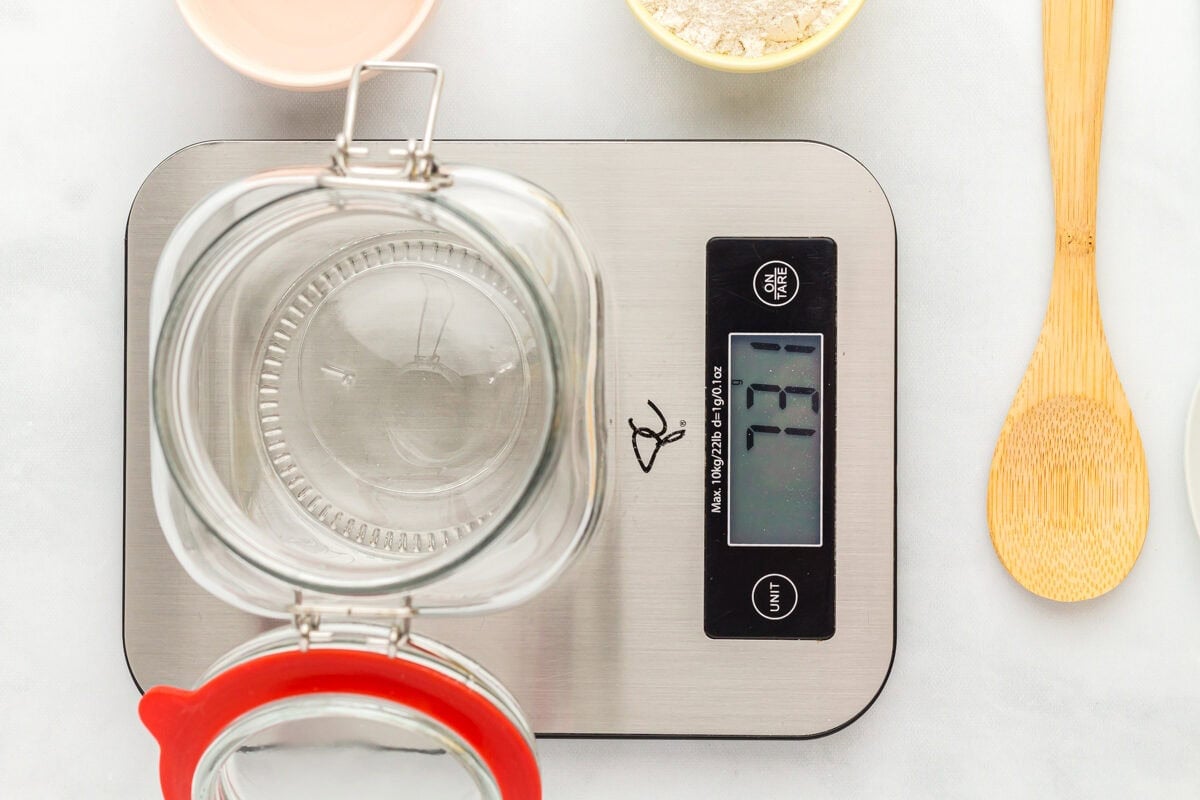
Weigh the empty glass jar. You’ll refer back to this weight daily so make sure you write the number down and have it near your prep area.
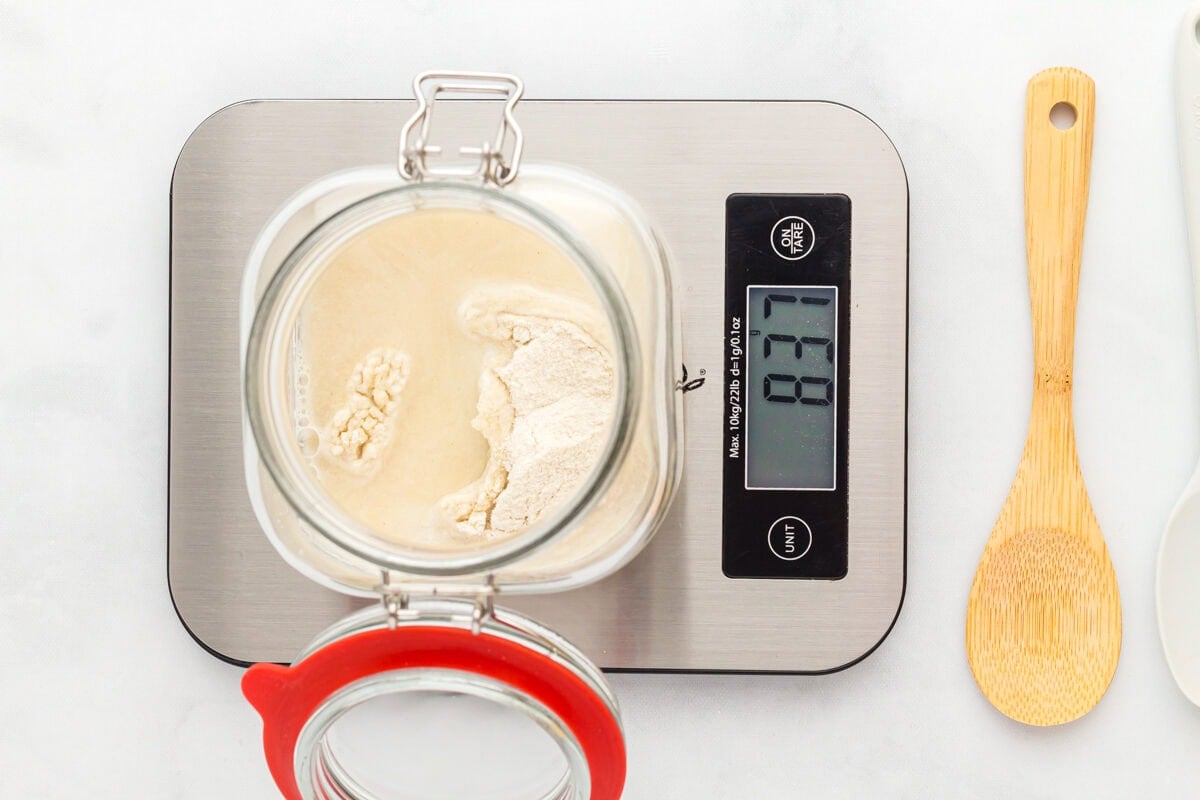
Day 1 First Feed: In the clean and dry glass jar, add 50 grams of brown rice flour and 50 grams of room temperature filtered water. It’s okay if you’re a few grams above or below 50 grams each when doing the daily feedings. The consistency should look like a thin paste that’s a bit thicker than pancake batter. Add a little extra water or flour if needed. Stir well with a wooden spoon, then use the spatula to scrape down the inside of the jar. Place the colored tape or elastic band at the height of the starter. Cover the jar loosely with a clean towel or plastic wrap and set it in a warm location in your home away from direct sunlight.
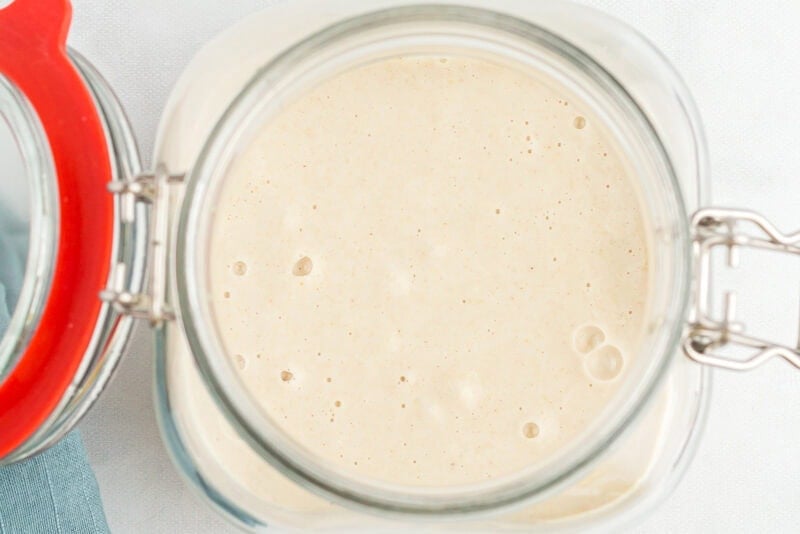
Day 1 Second Feed (12 hours after Day 1 First Feed): Stir the starter with a wooden spoon. Add an additional 50 grams of brown rice flour and 50 grams of room temperature filtered water. Stir well with a wooden spoon. Use the spatula to scrape down the inside of the jar. Move the colored tape or elastic band to the height of your starter. Cover the jar loosely with a clean towel or plastic wrap and set the jar back in a warm location.
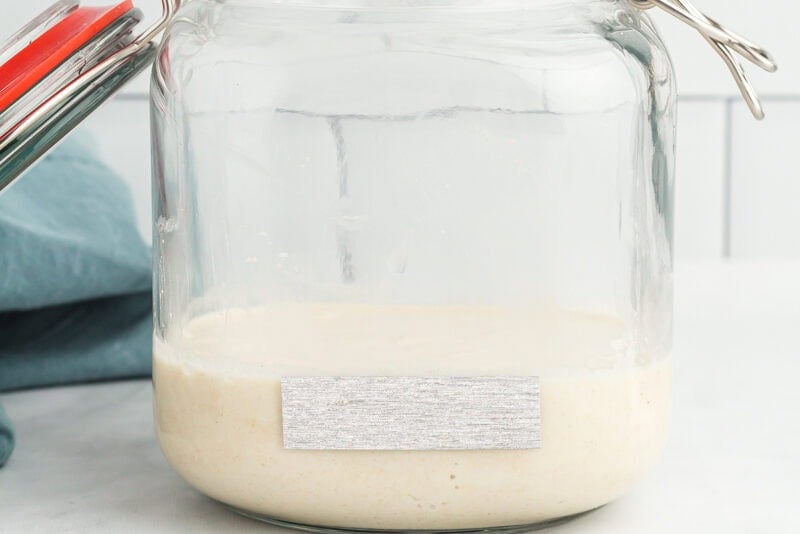
Day 2 First Feed (12 hours after Day 1 Second Feed): Repeat steps of Day 1 Second Feed.
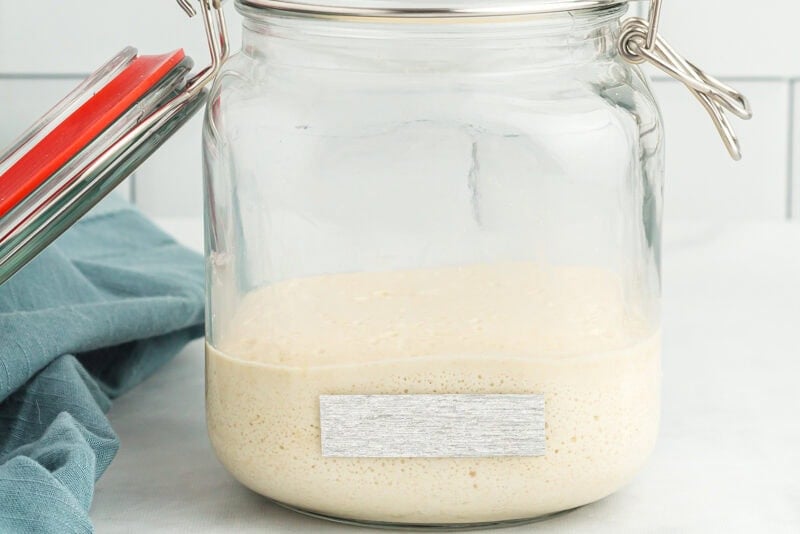
Day 2 Second Feed (12 hours after Day 2 First Feed): Repeat steps of Day 1 Second Feed.
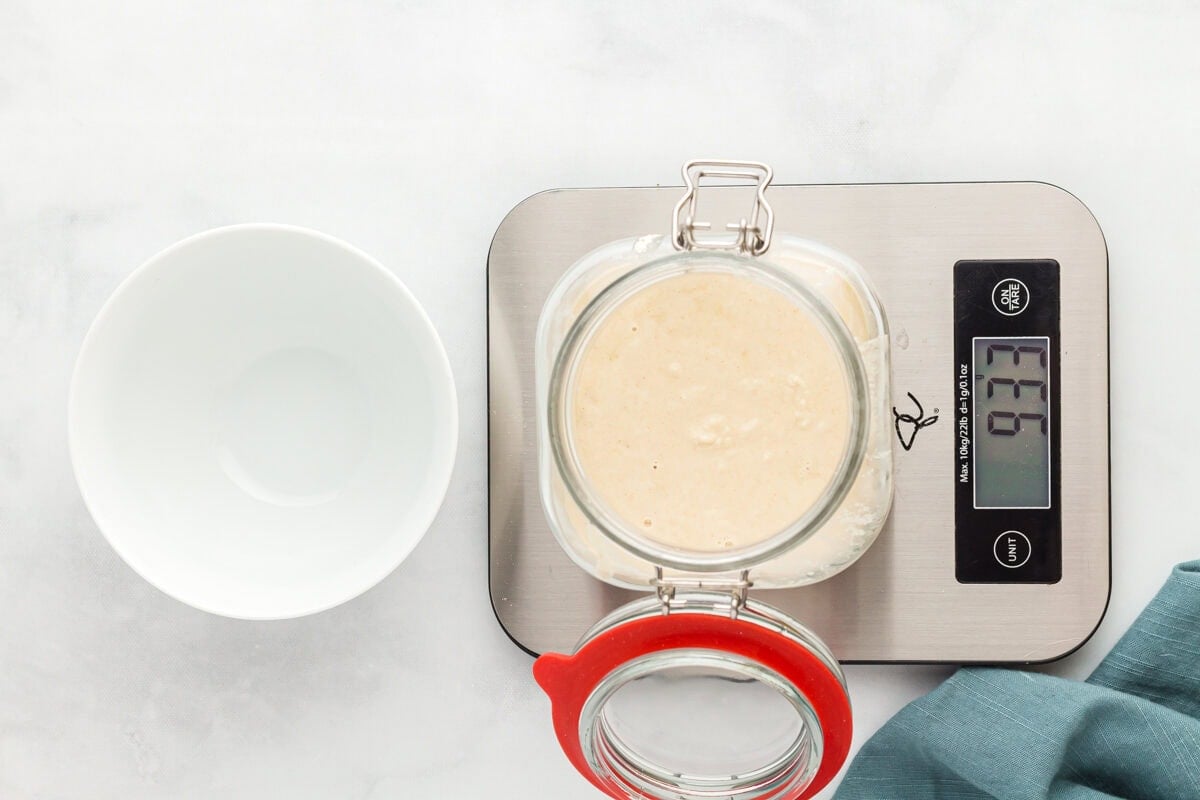
Day 3 First Feed (12 hours after Day 2 Second Feed): Stir with a wooden spoon. Discard all but 100 grams of the starter. This is where your math comes in handy. Let’s say your jar was 730 grams. When you stir and discard all but 100 grams, your food scale should now read approximately 830 grams (730 grams for the jar, plus 100 grams for the starter in it). Now add an additional 50 grams of brown rice flour and 50 grams of room-temperature filtered water. Using the math, the 730 jar plus the 100 grams of starter in it plus the 50 grams of additional brown rice flour plus the 50 grams of additional filtered water, the weight of all would now be around 930 grams. Stir well with a wooden spoon. Use the spatula to scrape down the inside of the jar. Move the colored tape or elastic band to the height of your starter. Cover the jar loosely with a clean towel or plastic wrap and set the jar in a warm location in your home.
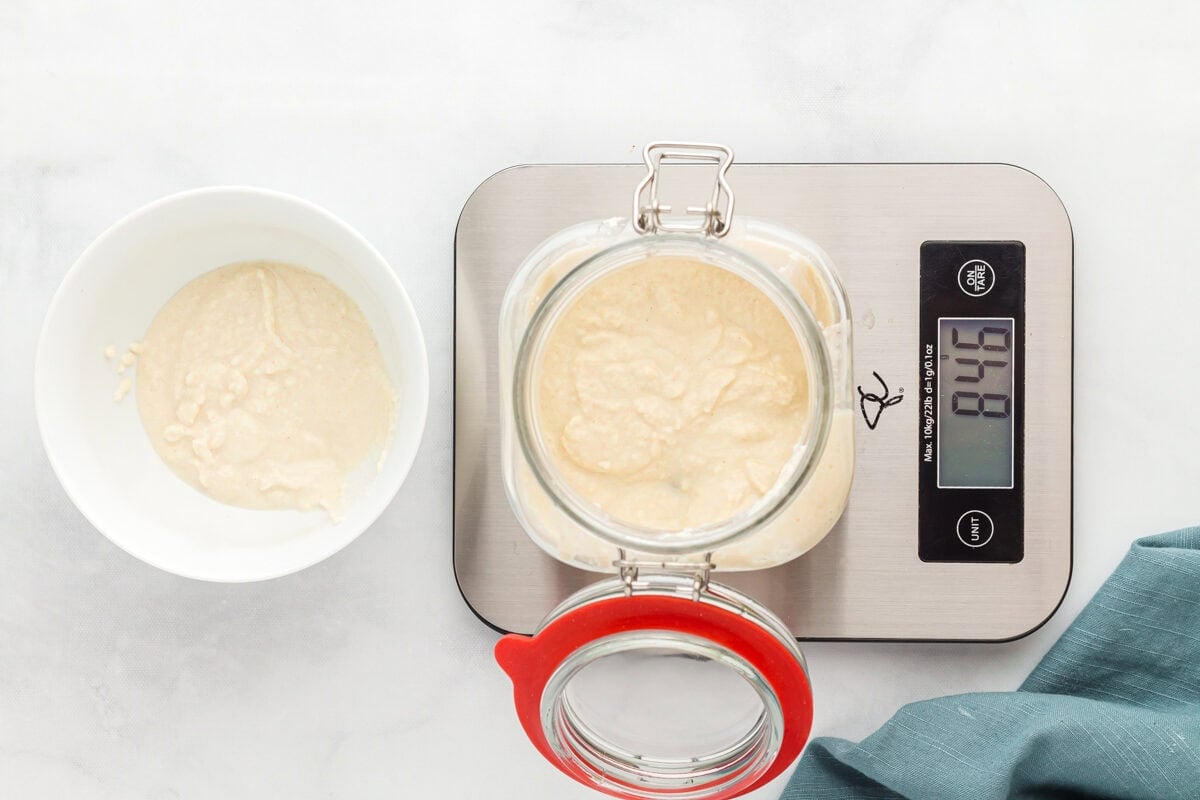
Day 3 Second Feed (12 hours after Day 3 First Feed): Repeat the steps of Day 3 First Feed.

Day 4 First Feed (12 hours after Day 3 Second Feed): Repeat the steps of Day 3 First Feed.
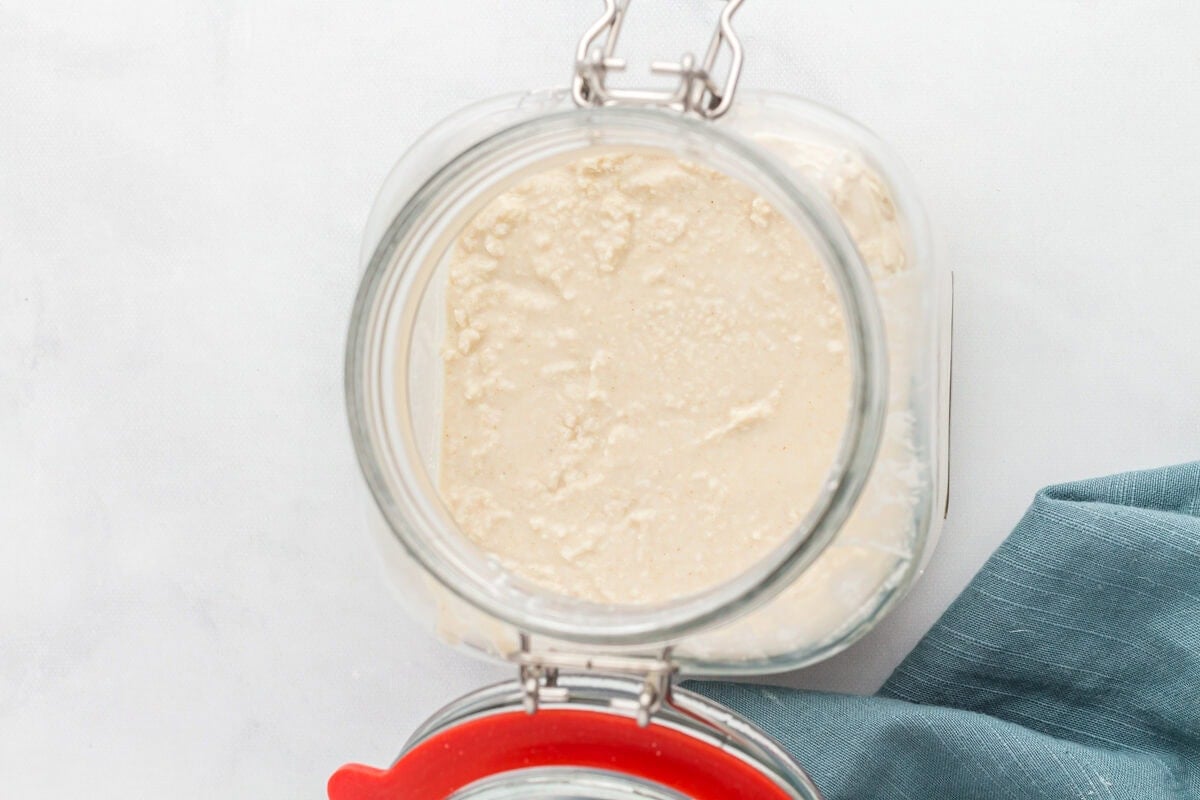
Day 4 Second Feed (12 hours after Day 4 First Feed): Repeat the steps of Day 3 First Feed.

Day 5 First Feed (12 hours after Day 4 Second Feed): Repeat the steps of Day 3 First Feed.

Day 5 Second Feed (12 hours after Day 5 First Feed): Repeat the steps of Day 3 First Feed.
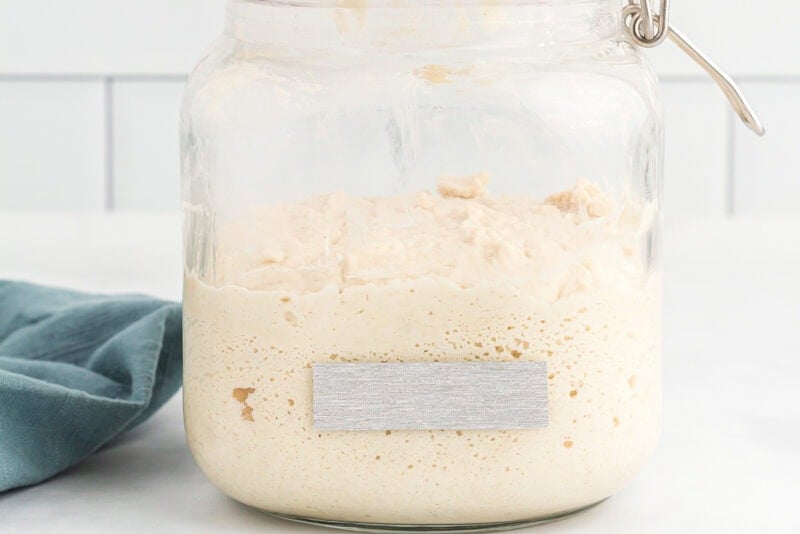
If you’re seeing good bubbles and a rise (almost doubling in height between feeds), then move on to Day 6 Feed instructions. If you aren’t seeing a good rise yet, don’t panic! Continue with Day 3 First Feed instructions until you see bubbling and height in your starter. The amount of time it can take to see a good rise is dependent on a lot of factors, including time of year, temperature inside the home, type of flour used, temperature of water used, etc. Be patient and keep going even if you aren’t seeing a lot of activity yet. If you’re seeing absolutely no activity (no bubbles, still a very loose consistency before feeds) after 5 days, it’s probably time to start over.
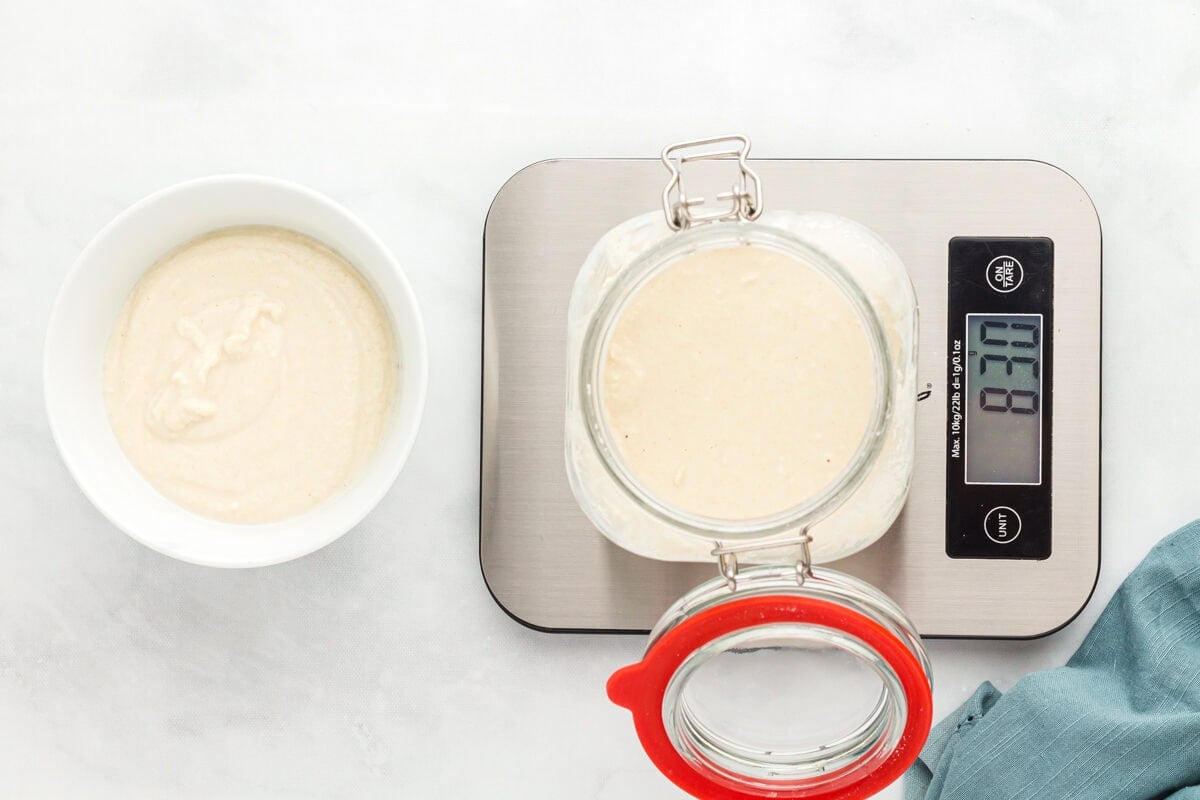
Day 6 Feed (24 hours after Day 5 Second Feed): It’s now time to move to once a day feeds. Stir the starter with a wooden spoon. Discard all but 100 grams. Add an additional 100 grams of brown rice flour and 100 grams of room-temperature filtered water. Using the math, the 730-gram jar plus the 100 grams of starter in it plus the 100 grams of additional brown rice flour plus the 100 grams of additional filtered water, the weight of all would now be around 1,030 grams. Stir well with a wooden spoon. Use the spatula to scrape down the inside of the jar. Move the colored tape or elastic band to the height of your starter. Cover the jar loosely with a clean towel or plastic wrap and set back in a warm location.

Day 7 Feed (24 hours after Day 6 Feed): Repeat the steps of Day 6 Feed.
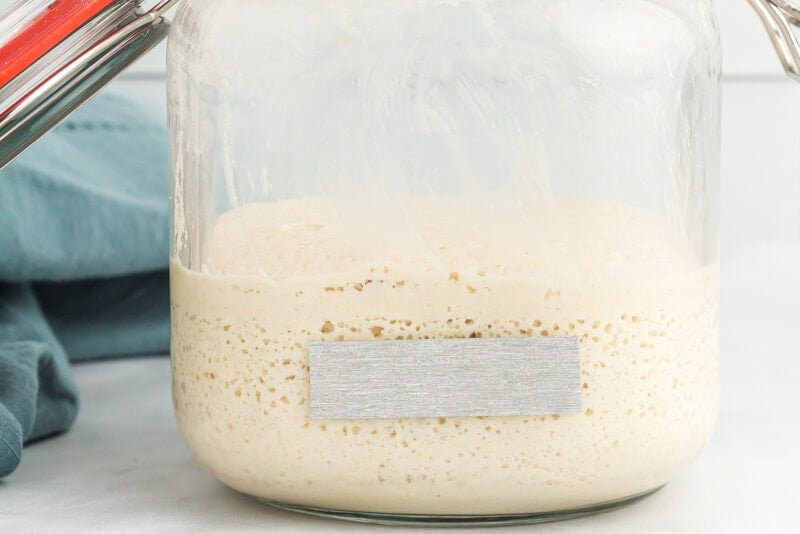
Repeat the steps of Day 6 Feed every 24 hours until you see the starter double in size within 4 to 6 hours after feeding. It should also have a pleasant, yeasty bread smell. Now, it’s finally ready to use for baking a loaf of gluten-free sourdough! This could take another full 7 days of daily feeds so be patient. Once your starter is at the maintenance phase, it can be stored in the fridge and will need weekly feedings.
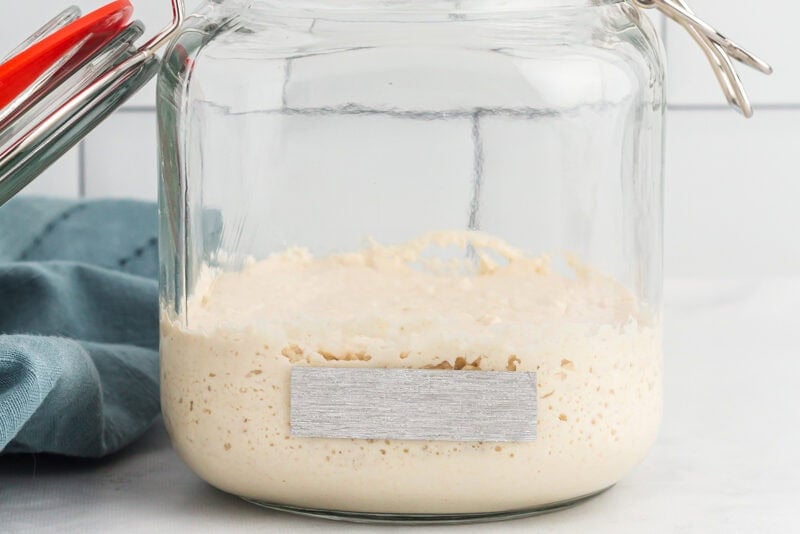
For Weekly Maintenance Feeds: Stir the starter with a wooden spoon. Discard all but 100 grams. Add an additional 100 grams of brown rice flour and 100 grams of room-temperature filtered water. Stir well with a wooden spoon. Use the spatula to scrape down the inside of the jar. Move the colored tape or elastic band to the height of your starter. Cover lightly and place back in the fridge.
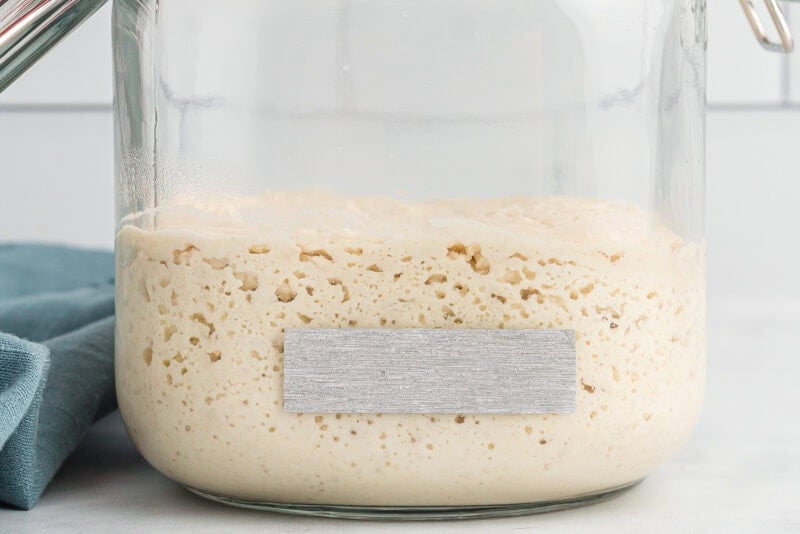
Before Baking: Remove the starter from the fridge, let sit at room temperature, feed as normal (100 grams each of starter, flour, and filtered water) then let sit for 4 to 6 hours until you see peak rise. If it hasn’t peaked within 12 hours, do another feeding (100 grams each of starter, flour, and filtered water).
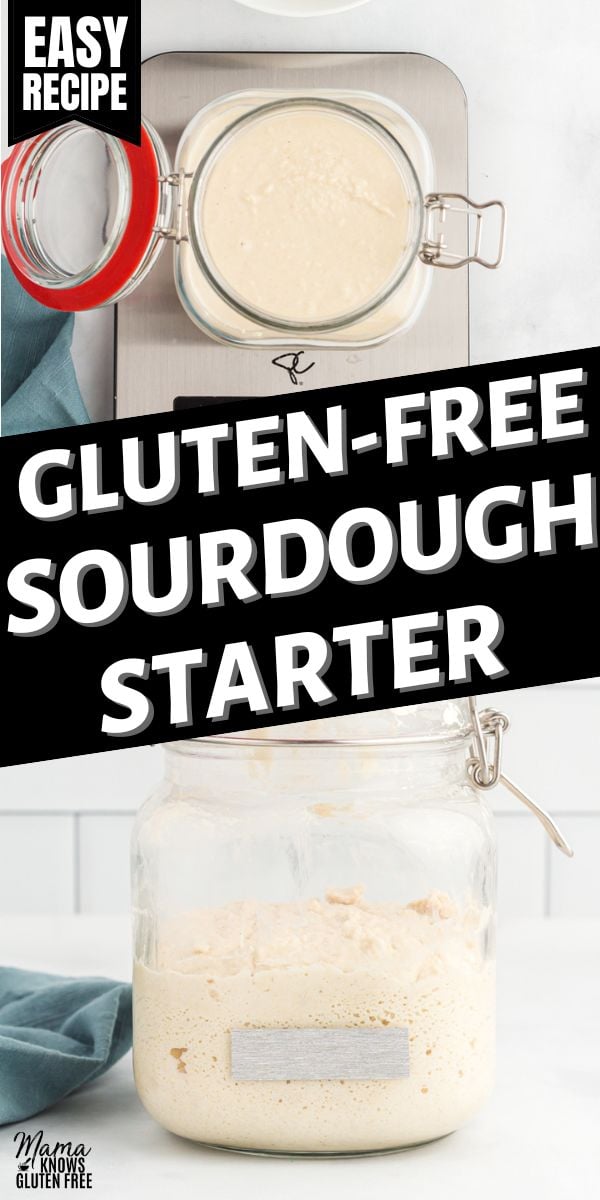


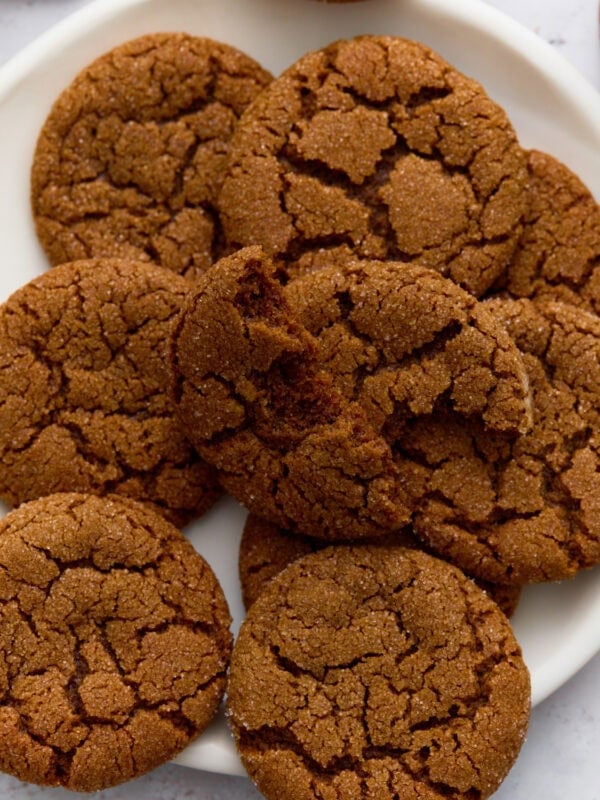
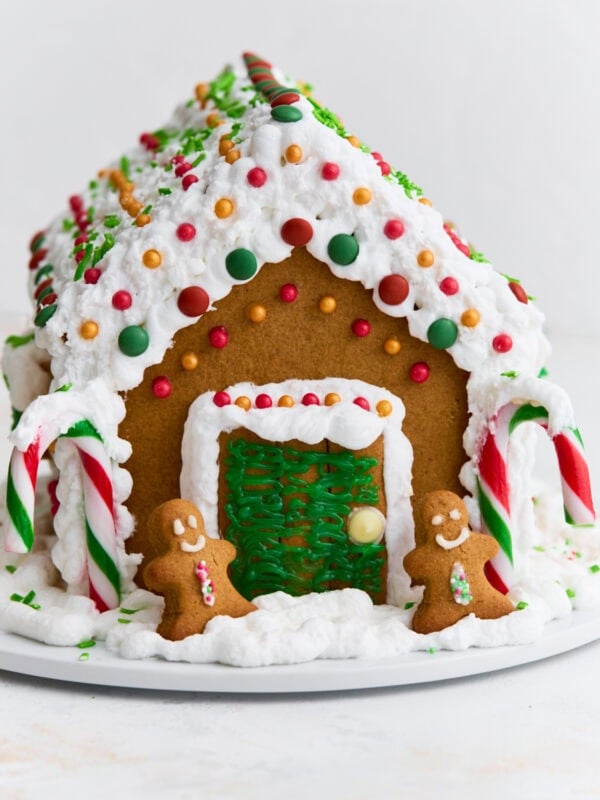






Thank you for your expansive explanation. I’m creating a starter for a friend who is GF. I would like to say that you can save yourself a lot of math hassle by pushing the ‘rare’ button to zero out your scale in adding your ingredients each time.
Have been using my starter for almost a year and have loved all I’ve been able to do with it! I did change it from brown rice flour to sorghum a few months ago, gradually, over a few weeks. It seems my starter hasn’t been the same since. It’s dryer, and doesn’t seem to get to peak rise easily in the fridge. Will it just take a while to bounce back after the switch? With it being dryer, should I be giving it more water? Thanks!
Hi Chelsea, Your observations are correct. Sorghum flour naturally absorbs more water than brown rice flour (less starch), so when you switched, it became thicker and less bubbly. Your starter just needs time to adjust to the new food you’re feeding it, and a little extra water. Instead of equal parts flour and water, go slightly higher on water (another tbsp or so). Observe it and see if you need to add more to get the airy texture back.
Thanks for all the information, this is great. I was thinking of making a gluten free sourdough loaf and was wondering a couple of things as I have never done this before.
When we get to the stage of making a sourdough loaf, do we use all of the starter or just half of the starter? When my sourdough starter is established, can I just put it in another jar instead of tossing it out and have two of them going in the fridge? I ask this as I am also wondering how many loaves can I make off of one starter at once, or is the starter meant to make one loaf by using half the starter and feeding the what remains?
Also, I buy a really good sourdough seeded loaf, which is super good, cannot even tell it is gluten free as it tastes like normal bread. I want to make something like a seeded (high fiber) sourdough loaf, any idea on how I can make a higher fiber bread.
Thank you for your help and your time.
Sincerely,
Debbie
Hi Debbie,
When you’re ready to bake a sourdough loaf, you only use part of your starter, not the whole jar. Think of your starter as your “mother” culture. You scoop out what you need for the recipe, and then you feed the starter that remains in the jar so it can keep living and growing. You can always build up more starter by feeding it a larger amount of flour and water before baking if you want to make multiple loaves in one day.
You can split your starter and keep two if you want! You might do this if you want to experiment with different flours, or keep one in the fridge and one on the counter. Just keep in mind that every starter you keep is something you have to feed.
For a seeded loaf, I’d suggest finding a good recipe and follow that. We haven’t tested this type of gluten-free sourdough load ourselves.
Is it safe to use the first discard on day 3 for other recipes?
Hi Elizabeth, Yes, it is technically safe, though it can really only be used for recipes like muffins, biscuits, or pancakes, or crackers. Be aware the flavor might be off and it won’t help your batter rise much until the starter matures.
Like regular sourdough, can the gluten free discard be used in recipes that call for discard? I hate to waste! TIA
Yup! There are lots of uses for discard! You can use the discard to add a distinct tangy flavor to biscuits, muffins, cookies, and pancakes. Store the discard in the fridge if you plan to use it later for another recipe.
for regular starter i don’t use glass. is that required? can I use king Arthur gluten free flour? I don’t have rice flour.
Hi Tonya, a glass jar is often suggested because it’s non-reactive and lets you see the bubbles, but ceramic or food-grade plastic also work fine. King Arthur Gluten-Free All-Purpose Flour works for a starter (it has no xanthan gum, which is good). You don’t have to use rice flour. Sorghum or millet flour can also work well.
My starter is showing a lot of activity (lots or bubbles and rising about 1.5x normal height for a couple of days now). I’m still feeding twice daily right now. Can I switch to once a day feedings or do I have to wait until I see the height double?
Hi Abby, I recommend continuing to feed twice daily until reliable doubling is visible, then you can drop to once daily.
I’m at once a day feedings now. I’ve noticed that my starter smells very much of alcohol. Like a lot more than it did when I was doing twice a day feedings. Can I use it to make bread still? Suggestions on what to do from here would be great!
Hi Abby, that alcohol smell is hooch, which is a sign your starter is hungry. Increase feedings again to 2x daily, or feed it a larger quantity relative to the starter: e.g., 1 part starter, 2 parts flour, 2 parts water–if you have 50g of starter, you’d feed it with 100g flour and 100g water. Stir the hooch in or pour it off before feeding. If it’s still rising predictably and bubbly after a feed, you can bake with it.
I’m excited to try this!
Hello, mine is doubling in size at 6 hours on the daily feed. But it collapses back down. Does that mean it’s still ready to be used?
Hi Julie, When your gluten-free (or any) sourdough starter doubles and then begins to collapse back down at around 6 hours, that collapse means it’s past its peak “ripe” window, but it was definitely strong enough before that. That doubling signifies maximum yeast and bacterial activity, which is the prime time to bake with it. You can still use it once collapsed, but your dough may behave differently (flatter loaf). Wait until it rises again to use if you’re looking for a better loaf rise.
Is there a preferred brand for the brown rice flour?
Hi Natalie, Bob’s Red Mill Rice Flour is probably most widely used and is available in most stores.
Hi,
Thank you for posting this. I have 2 questions. (1) is it normal to be sandy, (2) should it pass the water test when ready like regular sourdough starter?
Hi Sherri, Yes, the starter can have a gritty or sandy texture. This is typical and doesn’t necessarily indicate a problem. Over time, as fermentation progresses, it may become smoother, but some graininess is normal for certain gluten-free flours.
The water test isn’t reliable for gluten-free starters. Instead look for these signs:
Bubbles throughout the starter
A tangy, fermented smell
Slight rise and fall after feeding
A shift in consistency (more airy or fluffy over time)
Help! This is the second “recipe” I’ve tried for GF sourdough starter and not getting results. I’m on step 11 and haven’t seen any bubbles and no rise. Every feed looks the same as it did 12 hours before, like thick pancake batter. I don’t have a place in my house that is warmer than anywhere else, it’s all 70ish degrees. Using rice flour and purified drinking water.
Hi Amanda,
Not seeing bubbles or a big rise doesn’t necessarily mean it’s inactive. Look for subtle signs such as a mild sour aroma or small bubbles on the surface or sides of the container. Some bakers have noted that their gluten-free starters showed minimal rise but were still active.
If possible, try finding a warmer spot (75-80 degrees). You can turn your microwave or oven light on and keep the starter in there, if possible.
Purified water is great but make sure it’s free of chlorine. You could try spring water and see if that helps.
Adding a small amount of a starchy gluten-free flour, like tapioca or potato starch, can provide additional sugars for the yeast to consume, potentially boosting activity. Try 1 tbsp per feeding along with your usual food.
Patience is key! Gluten-free starters take longer to become active compared to their wheat-based counterparts. It’s not uncommon for a starter to take up to two weeks to show consistent activity.
Hope that helps!
Hi! Thanks for this recipe 🙂
First time making my own GF starter… I read through all below comments and also had a “false rise” around days 2-3… I also realized on day 8 (!!!) that I mis-measured my jar (thought it was 475g but it’s actually only 430g) – So that set me back a few days, I think! I was under feeding and continued seeing “hooch” on top… But the last 3 days seem to be moving in the right direction.
I’ve been diligent with feedings, am seeing bubbles and a pleasant yeasty/bread smell (day 11 first feed was today). Just waiting for the height – Should I be feeding any more than twice a day with 50g flour/50g water to boost the height?
Also want to mention it was very chilly and damp here in New Jersey last week… Perhaps the weather was not helping, either…
Thanks for any tips! Hope the information above is helpful 🙏🏻
Hi Mariel, Sounds like you’re doing everything right, yes the weather could have impacted it a bit but it’s still tracking good. Try increasing to 3 feedings/day for a couple days, keep it warm, and stay the course — sounds like you’re nearly there!
Hi! I’m using buckwheat flour and have been trying to do this. I was about to start over, since I started it March 17, but today is the first day I am seeing a little bit of rise to it. Is that ok? It has been very cold here.
Hi Elizabeth, That’s definitely okay! Buckwheat flours can take longer to get going, especially in colder weather. The fact it’s growing is a good sign it means it’s waking up. Try and find a warmer spot if possible but if not, it’s okay. Patience is key with buckwheat starters!
My starter was doubling in size and bubbling by day two, however, as soon as I started discarding all but 100 g with every feeding on day 3, it stopped doubling in size. It hasn’t done anything on day 3, 4, or 5. Is that normal?
Hi Sarah, Yes this can be normal. The initial bubbling is often caused by bad bacteria and wild yeast activity, but as you begin regular feedings, the beneficial yeast and lactic acid bacteria take time to establish. It’s common for a starter to seem sluggish around days 3-5. Just continue to stick to a consistent schedule, keeping it in a warm environment (if its stored in the fridge it slows down the process), and if there’s still small bubbles in the starter and it smells tangy but not rotten then its alive.
Hi, my niece asked if I would find out how to make her gluten free sour dough bread then show her how to make it, I have been following your starter recipe to a T, all is good so far, I’m on day 8, question here, so every 24 hrs do I take out all except for 100 grams? Every 24 hrs? For how long?
How do I know when I can make the bread?
Thank you for your help
Hi Janet,
Yes, repeat the steps of Day 6 Feed every 24 hours until you’re seeing the starter double in size within 4 to 6 hours after feeding. It should also have a pleasant, yeasty bread smell. Once you see that, it’s ready to use for baking a loaf of gluten-free sourdough! This could take another full 7 days of daily feeds so be patient.
found out the hard way that you cannot use the discard in any recipes for atleast a month. And can’t use the starter for a few weeks because of the harmful bacteria. had no idea should’ve done more research. Got rather sick because I used discard in a recipe prematurely.
Hi Bernadette, So sorry you got sick! In our experience, it’s ready once it has doubled in size, has lots of bubbles, and there’s enough for 1 loaf of bread.
Did you use the first discard? How long should I wait to use the discard?
Did you get a response to this?
I was wondering the same thing.
Hi Cheryl,
Thank you so much for posting this! I have been making sourdough for quite a while now, mostly for pizza dough. I have found as I’ve gotten older that I am a bit gluten sensitive, so I’m excited to try this! I have a Brod and Taylor sourdough home, and was wondering what your recommendation would be for the temperature setting for growing this starter?
Hi Shawn, I would follow the recommendations on the Brod and Taylor site: https://brodandtaylor.com/products/sourdough-home. Hope that helps!
I’m on day 6 and already the starter is doubling in 4-6 hrs. Does this mean it’s ready to use?
Yes!
Hello, How do i maintain the sourdough after this process is finished?
Hi Jasper, For Weekly Maintenance Feeds: Stir the starter with a wooden spoon. Discard all but 100 grams of the starter. Add an additional 100 grams of brown rice flour and 100 grams of room temperature filtered water. Stir well with a wooden spoon. Use the spatula to scrape down the inside of the jar. Move the colored tape or elastic band to the height of your starter. Cover lightly and place back in the fridge.
I thought my starter was ready. I was on the “Day 7 Feed” which took about a week and double in size within 6 hours. I waited 24 hours and put in the fridge for maintenance and it is now back down to regular size and no longer doubled. Did I do something wrong?
Hi Sam, putting it in the fridge slows activity, so you will notice it does not rise as high. This is normal!
Hello, my starter has been living in my fridge now since I had reached maintenance a few months back. I take it out weekly to feed it, have it in my oven with the light on to grow and then take out what I need for my bread then put it back in the fridge.
This past weekend I had it in the oven for about 12 hours and it had no growth at that point. It looked like it grew and then deflated.
I fed it again and put it back to grow. At 6 hours it had doubled in size and then after 6 hours it began to go back down again. What is happening? Is my starter no longer good?
Hi Sam, It’s still good! The starter is a living organism so there’s going to be some progress and regression, it’s natural. When it grows its fermenting and eating the food, it collapses because there’s nothing left to eat. Likely what happened when you left the starter in the oven for 12 hours, was it finished eating between hours 6-8 and then collapsed because it ran out of food. You can try giving it more food or adjusting your feeding time. But it’s very much still alive!
I appreciate your post. I have been baking GF yeast bread successfully for 10 years, but haven’t tried sourdough. I have my starter brewing and can’t wait to make bread.
I wanted to share my experience. I had moderate success with the rice flour, after a few days I began feeding sorghum and it became more active. As an experiment, last night I divided put 25 grams into 2 jars and fed one with Teff and one with buckwheat at a 1-2-2 ratio.
Both the Teff and buckwheat more than doubled in 8 hours – the sorghum (also fed 1-2-2) did not double.
Note: I fresh mill all the above grains.
Thanks for the inspiration!
Hi Cheryl
Thank you this is great.
Do you have a place that tells us how to bake it?
Hi Alyssa, we do have a GF sourdough bread recipe (click here!).
Can I substitute regular white rice flour? I don’t have any brown rice flour on hand?
Hi Audrey, we recommend a whole-grain GF flour, like buckwheat, teff, millet, rice, or sorghum.
Thank you so much I have been making a lot of sourdough lately but not gluten free – I only was on day 2 and only fed it once a day. I woke up this AM and the jar was almost full it rose so well could not believe it. I did grind my own Walmart brown rice not sure if that it why on day 2 it rose so well.
Anyrate I went to day 6 and added 100G starter, 100G warm water, 100G rice flour. I will keep you updated as how this is working. Even though it doubled in size by day 3 with only one feeding per day I don’t think that it is strong enough for baking.
Thank you for the awesome instructions and helpful hints. This is my first experience in the world of sourdough so I appreciate the level of detail you provided. Quick question- days 1 and 2 had the starter doubling in size. As soon as I started discarding on day 3, I stopped getting any rise but I do see activity (bubbling, thickening of the starter…appears frothy). I am now on day 5 with still no rise but activity remains. Is this normal? I know you mentioned that when you go to feedings every 24 hours to expect less activity so I was surprised to find far less activity as soon as I started discarding on day 3, especially after so much activity on days 1 and 2. Would love to hear your thoughts and if you think I should proceed to day 6 after my day 5 is complete. Thanks!
Hi Suzan, less activity is okay as long as there is still some activity. A super bubbly starter in the first few days is usually just the bad bacteria dying off to make room for the good bacteria. We recommend continuing as normal!
Hi Sam, I am on day six and I have never seen bubbles. My starter is actually pretty dry. I live in Miami where there is humidity outside, but inside the AC is on 24/7. I have the starter on my kitchen counter over an area that’s warm from a beverage refrigerator under it. Any suggestions would be greatly appreciated. I am using King Arthur’s gluten-free bread flour. Thanks in advance.
Hello, if your starter seems dry and isn’t showing any activity, we recommend feeding it more frequently (every 8 hours instead of 12) until it picks back up. We would also recommend adding a little extra water until it is no longer dry and looks more like the starter in the photos. Different brands of GF flour can vary in how much hydration they need, so it may take a bit of experimenting to find what works best for your starter.
I’m on day 4 feed 2 and am noticing the water is slightly separating in between feeds. Is this normal? I’m stirring before and after every feeding. Should I do anything different?
The liquid is totally normal and can be stirred back in or discarded!
How long is liquid normal for? Seeing lots of bubbles but still noticing a thin consistency prior to feeding and liquid still separating, I’m on day 13 now
Hi Isabelle, it sounds like your starter is hungry! You may want to feed it more frequently.
Good morning, my starter started to have water on top on day 4. I traveled to a higher elevation. Is it still good? Today is my day 5. However, before I left on day 3 it was bubbly. Please let me know what to do!
Dianna
Hi Dianna, that water is more than likely actually what we call “hooch”. You can stir it in or pour it off before feeding your starter, but do feed it soon. Hooch is a sign that it’s hungry!
Hi! 👋🏻 This will be a first for me baking with gluten free starter. My question regarding storing in the refrigerator after the starter is mature. Doesn’t it have to rise a little after feeding before it’s placed in the refrigerator? I have to do that with my non-gluten free starter. After I’ve fed it I wait a couple hours to see activity and then place in the fridge if I won’t be baking that week. That wasn’t mentioned here and so I genuinely am curious. Thank you
Hi Elizabeth, we did not wait to see any activity before storing in the fridge, but you certainly could!
Good evening, thank you for sharing your recipe. I was wondering if you sell the gluten free starter?
Thank you,
Dianna
Hi Dianna, unfortunately, we do not sell gluten-free starter!
How much yeast should be used? If it was mentioned, I fully missed it lol.
Hi Taylor, there is no commercial yeast in this recipe. The yeast comes from natural organisms in the flour and develops over time as you continue to feed the starter.
Hey Cheryl,
Me again. I’m on day 6 (where you go 24 hours between feeds) and my starter rose half way then fell after 12 hours. Should I feed it since it’s fallen, or wait for the 24 hours mark?
Hi Kimberly, it sounds like your starter may be ahead of schedule and you can skip to weekly maintenance feeds. You can also continue to feed every 24 hours at room temperature if you prefer.
Hey Cheryl!
I’ve never had success with sourdough before, but I’m determined to do it right this time. When the starter is established and is in maintenance mode and I’m ready to use it to bake with, do I discard all but 100 g, feed it and then use whatever the recipe calls for? or do I just feed it and then use what I need? Do I need to make sure there is at least 100 g left?Thanks for your help!
Hi Kimberly, we recommend always leaving about 100g of your starter behind to keep it going!
When you say before baking feed as normal what if it is not time to feed. Say I fed it on Sunday and feed it once a week and it’s now Wednesday? Do I take it out let it get to room temperature and then feed and discard again? Also can I stick back in the fridge when done. Thanks!
You should always feed it just before you plan to bake with it! Depending on how active your starter is, that can be anywhere from 2-12 hours. You can stick the remaining starter back in the fridge when you’re don with it.
Before my day 3 feed my starter was doubling and overflowing my quart jar. Have I done something wrong?
Hi Cindy, on or around day 3, you may experience a “false rise” caused by bacterial bloom as your starter is working to get the good bacteria to overwhelm the bad. It may smell “off” during this time, but no need to panic! It should go back to normal within a few days, so continue to follow the recipe!
Hi! Thank you so much for this recipe. When my starter is ready to use for baking can it be used with any gluten free flour? Or can I only bake with the brown rice flour that I’ve created the starter with?
Hi Kelsey, you should be able to use this starter with any gluten-free flour!
I had FANTASTIC bubbles on day 3 but since then it has not bubbled. What would have caused this? It was really warm that day but I have not had any rise since that day. What should I do? It’s day 5 so should I just throw it out and start over?
Thanks in advance!
Hi Kayla, starter takes time to get established. Unless you see mold, you are fine to keep going!
Hello! I just did day 4 feed 1 on my new starter. I’m curious when you say to repeat the day 3 feed 1, does that also include discarding so there’s only 100g of starter left? Thanks!
Hi Emma! Yes, you’ll start by discarding all but 100g of the starter before adding the additional flour and water.
I am sorry, but I am confused on what you mean by discarding all, but 100 grams of the starter? Is it keeping a 100 grams in the original jar and transferring the rest into a new jar? Then, when Day 6 comes along and you say to add a 100 grams of starter to the 730 gram jar, are we adding the 100 grams earlier that we saved?
Hi Adyson, you discard all but 100 grams, meaning the rest can be used in a discard recipe or thrown away. Keep the 100 grams in your jar, then add 100 grams to that at each feed. The empty jar itself (just the glass) weighs about 730 grams, so the recipe developer took that into account when writing the instructions. To simplify, you can “tare” your scale so that it reads “0” when the empty jar is on top of it.
Do you think White Rice Flour would also work?
Hi Laura! Yes, white rice flour should work as well.
I am very excited to try this! Will you be posting gf sourdough bread recipes?
Hi Chris, check out our new post, gluten-free sourdough bread (click here) for a recipe!
Hi Audrey. When the dough is ready and we are storing it for future use, is the jar kept sealed or still open to allow air flow?
Hi Lidia! The jar of starter should be covered but not sealed.
hey there! question about discard… can I use this discard immediately or does the discard need to be thrown away the first couple of times?
thanks!